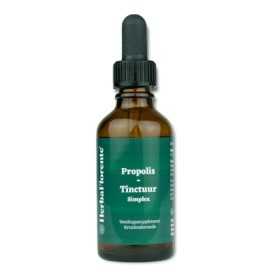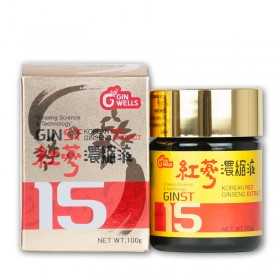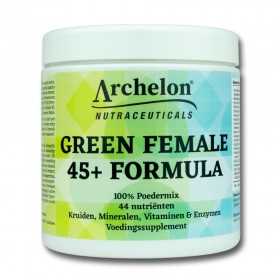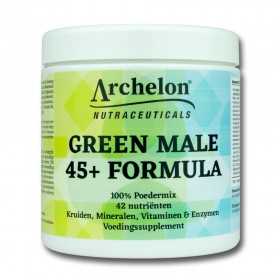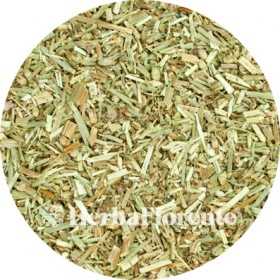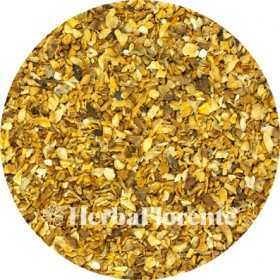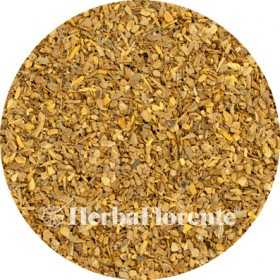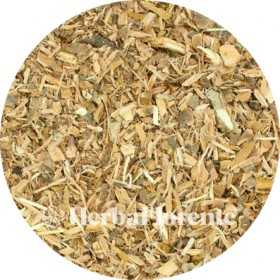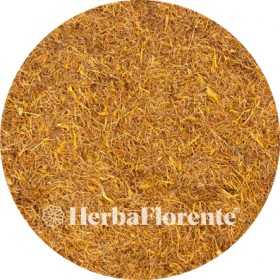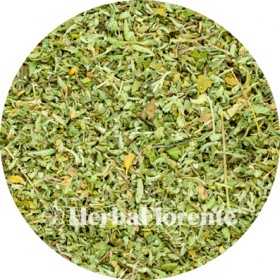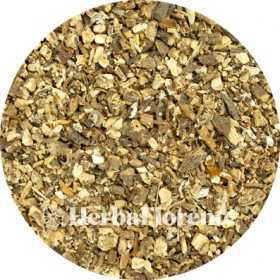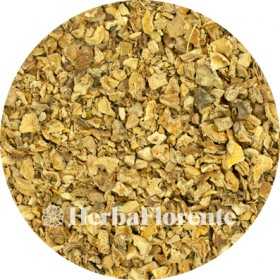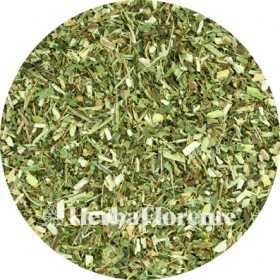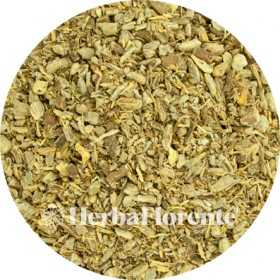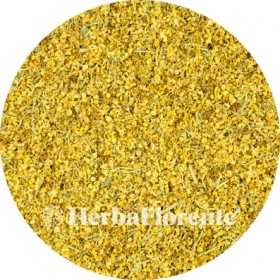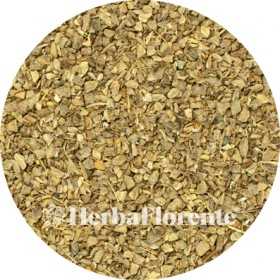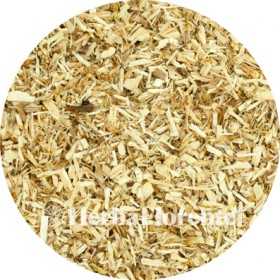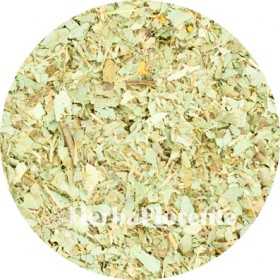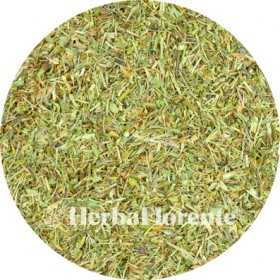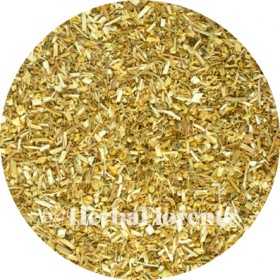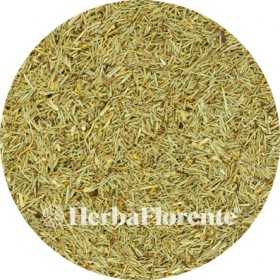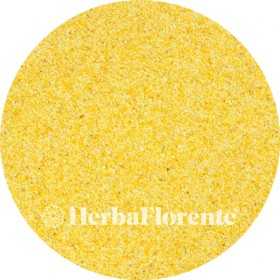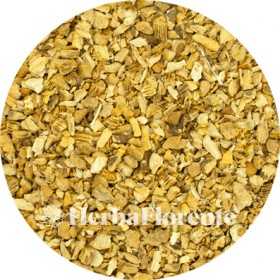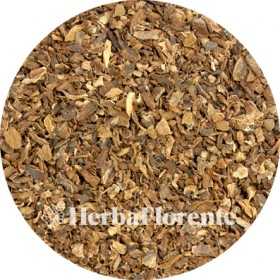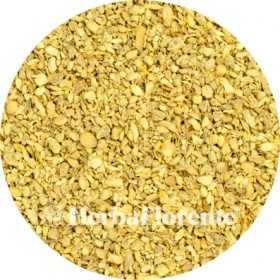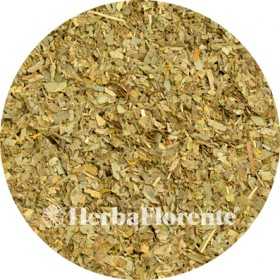A, B, C, .... X, Y, Z
There are 114 products.
Chicory (Herb) - Cichorium Intybus
Chicory (Cichorium) belongs to the composite family (Compositae or Asteraceae) and includes well-known vegetables such as chicory and endive. It is mainly consumed for health reasons.
Since the late years of the twentieth century, chicory roots have been cultivated not only for chicory, but also for the production of inulin and sweeteners, especially fructose. Both inulin (a dietary fiber) and fructose are widely used in the food industry.
Roasted chicory root is used as a coffee substitute or as an ingredient in coffee brewing. In the past, this was done out of necessity, such as during the Napoleonic blockade during the French occupation.
Since the late years of the twentieth century, chicory roots have been cultivated not only for chicory, but also for the production of inulin and sweeteners, especially fructose. Both inulin (a dietary fiber) and fructose are widely used in the food industry.
Roasted chicory root is used as a coffee substitute or as an ingredient in coffee brewing. In the past, this was done out of necessity, such as during the Napoleonic blockade during the French occupation.
€2.00
From: €2.00
Chicory (Root) - Cichorium Intybus - Cut
Chicory (Cichorium) belongs to the composite family (Compositae or Asteraceae) and includes well-known vegetables such as chicory and endive. It is mainly consumed for health reasons.
Since the late years of the twentieth century, chicory roots have been cultivated not only for chicory, but also for the production of inulin and sweeteners, especially fructose. Both inulin (a dietary fiber) and fructose are widely used in the food industry.
Roasted chicory root is used as a coffee substitute or as an ingredient in coffee brewing. In the past, this was done out of necessity, such as during the Napoleonic blockade during the French occupation.
Since the late years of the twentieth century, chicory roots have been cultivated not only for chicory, but also for the production of inulin and sweeteners, especially fructose. Both inulin (a dietary fiber) and fructose are widely used in the food industry.
Roasted chicory root is used as a coffee substitute or as an ingredient in coffee brewing. In the past, this was done out of necessity, such as during the Napoleonic blockade during the French occupation.
€2.00
From: €2.00
Cinnamon - Cinnamomi ceylon - Cut
Cinnamon (Cinnamomum) has been known for centuries for its many uses. It is extracted from the bark of the Cinnamomum verum tree, where part of the bark is carefully cut loose and the rough outer surface is removed with a knife. The well-known cinnamon sticks or cinnamon powder are made from the inside of the bark. Cinnamon has been valued for centuries, both in culinary and herbalist circles.
This herb has been used in Asian cultures for centuries for its versatile uses. The wonderful aroma of cinnamon is determined by volatile oils, of which cinnamaldehyde is the most common. In addition, cinnamon also contains substances such as eugenol, coumarins, tannins, OPCs and terpenes.
This herb has been used in Asian cultures for centuries for its versatile uses. The wonderful aroma of cinnamon is determined by volatile oils, of which cinnamaldehyde is the most common. In addition, cinnamon also contains substances such as eugenol, coumarins, tannins, OPCs and terpenes.
€3.00
From: €3.00
copy of Witch Hazel (Bark) - Hamamelis virginiana
The American witch hazel (Hamamelis virginiana) is a shrub belonging to the family Hamamelidaceae, native to North America from Nova Scotia to Minnesota, and from southern and central Florida to eastern Texas.
The shrub can reach a height of 6 to sometimes even 10 meters, with a bushy growth thanks to the many branches that arise just above the ground. The bark is light brown, smooth but somewhat flaky, and shows a reddish-purple color on the inside.
Blooming from September through October, the flowers of the American witch hazel display clusters of 4 stamens. They usually range from pale yellow to bright yellow, although orange or red hues also occur. The petals are ribbon-shaped and measure 10-20 mm in length.
The shrub can reach a height of 6 to sometimes even 10 meters, with a bushy growth thanks to the many branches that arise just above the ground. The bark is light brown, smooth but somewhat flaky, and shows a reddish-purple color on the inside.
Blooming from September through October, the flowers of the American witch hazel display clusters of 4 stamens. They usually range from pale yellow to bright yellow, although orange or red hues also occur. The petals are ribbon-shaped and measure 10-20 mm in length.
€5.20
From: €5.20
Corn Silk - Zea mays Conc.
Dried corn silk, also called stigmas, are used in herbal medicine. When fresh, these hairs are green in color, but once dried they turn dark brown to black.
Corn silk, also known as corn beard, can have beneficial effects on fluid balance, bladder inflammation (soothing) and irritation of the urinary tract (soothing).
Corn silk, also known as corn beard, can have beneficial effects on fluid balance, bladder inflammation (soothing) and irritation of the urinary tract (soothing).
€2.00
From: €2.00
Damiana - Damianae mex. (Turnera diffusa) - Cut
Damiana (Turnera diffusa) is a shrub native to southern Texas in the United States, as well as Central America, Mexico, South America and the Caribbean. It belongs to the Passifloraceae family and has been used by the Mayan Indians for centuries for its known effects on libido. Both men and women benefit from the libido-supporting properties of damiana, which is also known for its stress-reducing effect.
In Mexico, women often prepare tea from the fragrant leaves of the damiana shrub or smoke them to stimulate their feelings of pleasure. Damiana leaf contains several active substances, including beta-sitosterol, arbutin and alkaloids.
In Mexico, women often prepare tea from the fragrant leaves of the damiana shrub or smoke them to stimulate their feelings of pleasure. Damiana leaf contains several active substances, including beta-sitosterol, arbutin and alkaloids.
€4.60
From: €4.60
Dandelion (Herb) - Taraxum officinale - Cut
Dandelion (Taraxacum officinale) has been known for centuries for its ability to support liver and gallbladder function. Both the root and the above-ground parts of the plant are rich in nutrients. In addition, dandelion has a beneficial effect on digestion.
The rich nutritional value of dandelions makes it advisable to regularly pick some fresh leaves in the wild and add them to salads. They are especially tasty in the spring. The fresh yellow flowers can be used as a cheerful decoration in salads and dried they can be processed into a 'wild' herbal tea.
Dandelions contain a high level of bitter substances, which always indicates that they are beneficial for liver and gallbladder function.
The rich nutritional value of dandelions makes it advisable to regularly pick some fresh leaves in the wild and add them to salads. They are especially tasty in the spring. The fresh yellow flowers can be used as a cheerful decoration in salads and dried they can be processed into a 'wild' herbal tea.
Dandelions contain a high level of bitter substances, which always indicates that they are beneficial for liver and gallbladder function.
€2.20
From: €2.20
Dandelion (Root) - Taraxum officinale
Dandelion (Taraxacum officinale) has been known for centuries for its ability to support liver and gallbladder function. Both the root and the above-ground parts of the plant are rich in nutrients. In addition, dandelion has a beneficial effect on digestion.
The rich nutritional value of dandelions makes it advisable to regularly pick some fresh leaves in the wild and add them to salads. They are especially tasty in the spring. The fresh yellow flowers can be used as a cheerful decoration in salads and dried they can be processed into a 'wild' herbal tea.
Dandelions contain a high level of bitter substances, which always indicates that they are beneficial for liver and gallbladder function.
The rich nutritional value of dandelions makes it advisable to regularly pick some fresh leaves in the wild and add them to salads. They are especially tasty in the spring. The fresh yellow flowers can be used as a cheerful decoration in salads and dried they can be processed into a 'wild' herbal tea.
Dandelions contain a high level of bitter substances, which always indicates that they are beneficial for liver and gallbladder function.
€2.50
From: €2.50
Devil's Claw - Harpagophytum procumbems
The devil's claw (Harpagophytum procumbens) gets its name from the claw-like spines that cover the fruits. The name is derived from the Greek word 'harpagos', meaning 'anchor', which refers to the shape of the plant. The plant grows mainly in the Kalahari Desert, which extends across parts of Namibia, Botswana and South Africa. A distant relative of the sesame plant, the devil's claw blooms with beautiful red to purple trumpet-shaped flowers. The medicinal properties of devil's claw are located underground, in the tubers and roots. The plant is known for its beneficial effect on digestion and promoting flexible joints.
€2.60
From: €2.60
Echinacea (Coneflower) (Herb) - Echinaceae purp.
Purple coneflower (Echinacea purpurea) is one of the most widely grown and used herbs in the world because of its positive influence on the immune system. The genus name 'echinacea' is derived from the Greek word 'echinos', meaning 'hedgehog', because of the spiky flower cone. Since the beginning of the last century, much research has been done into Echinacea purpurea in Europe.
This plant has a rich history and originally comes from North America. Indigenous tribes used this perennial plant for its beneficial effects on the immune system. Colonist doctor H.C.F. Meyer adopted this knowledge from the indigenous population and brought the first product based on echinacea onto the market in 1871.
This plant has a rich history and originally comes from North America. Indigenous tribes used this perennial plant for its beneficial effects on the immune system. Colonist doctor H.C.F. Meyer adopted this knowledge from the indigenous population and brought the first product based on echinacea onto the market in 1871.
€2.00
From: €2.00
Echinacea (Coneflower) (Root) - Echinaceae purp.
Purple coneflower (Echinacea purpurea) is one of the most widely grown and used herbs in the world because of its positive influence on the immune system. The genus name 'echinacea' is derived from the Greek word 'echinos', meaning 'hedgehog', because of the spiky flower cone. Since the beginning of the last century, much research has been done into Echinacea purpurea in Europe.
This plant has a rich history and originally comes from North America. Indigenous tribes used this perennial plant for its beneficial effects on the immune system. Colonist doctor H.C.F. Meyer adopted this knowledge from the indigenous population and brought the first product based on echinacea onto the market in 1871.
This plant has a rich history and originally comes from North America. Indigenous tribes used this perennial plant for its beneficial effects on the immune system. Colonist doctor H.C.F. Meyer adopted this knowledge from the indigenous population and brought the first product based on echinacea onto the market in 1871.
€3.00
From: €3.00
Elder - Sambuci nigri
The elder (Sambucus nigra L.) is a native tree/shrub in the Netherlands that is widespread in various places in our country. Towards the end of May the elder tree blooms and produces large umbels of small, creamy white flowers that give off a sweet, floral scent. These blossoms are used to make elderflower liqueur, syrup or pancakes. In addition to their delicious taste, the blossoms are also rich in substances, including up to 3% flavonoids such as rutin, quercetin and astragalin. In addition, they contain tannins (tannins), triterpenes, fatty acids and essential oil.
€3.60
From: €3.60
Elecampane - Inula helenium
The Elecampane (Inula helenium) is a perennial plant that belongs to the composite family (Compositae or Asteraceae). This plant is naturally found in Western and Central Asia and has been known for its culinary and medicinal uses since ancient times.
The ancient Greeks called the plant helenion, which means "the radiant, the splendid." This name is related to hèlios, which means "sun". There are several myths surrounding the naming. The Romans adopted the Greek name and called the plant inula. When Linnaeus introduced the scientific Latin name Inula helenium in 1753, he combined the Roman genus name with the Greek specific name.
The ancient Greeks called the plant helenion, which means "the radiant, the splendid." This name is related to hèlios, which means "sun". There are several myths surrounding the naming. The Romans adopted the Greek name and called the plant inula. When Linnaeus introduced the scientific Latin name Inula helenium in 1753, he combined the Roman genus name with the Greek specific name.
€2.20
From: €2.20
Eleutherococcus (Siberian Ginseng) - Eleutherococcus - Cut
Siberian ginseng (Eleutherococcus senticosus) has had a good reputation in both China and Russia for centuries as a supporter of the immune system. Siberian ginseng root extract is beneficial for memory and concentration.
The carrots are a rich source of beta-carotene, vitamins B1, B2, C and E, and they are high in eleutherosides. It is important not to confuse Siberian ginseng with its Korean variant (Panax ginseng) or the American one (Panax quinquefolius). Not only do the names differ, but also the properties.
The carrots are a rich source of beta-carotene, vitamins B1, B2, C and E, and they are high in eleutherosides. It is important not to confuse Siberian ginseng with its Korean variant (Panax ginseng) or the American one (Panax quinquefolius). Not only do the names differ, but also the properties.
€2.20
From: €2.20
Elm - Ulmi camp. - Cut
The elm (Ulmus), also known as olm, is a genus of deciduous trees. These trees have feather-veined leaves with a serrate or double-serrate leaf edge. They bloom before the leaves appear, with small green perianths whose petals are fused together. Above the perianths are the stamens with purple anthers and the pistil. The seeds of the elm are flattened and have a broad, winged edge. Elms thrive best in fairly nutrient-rich, moist and calcareous soil.
€2.00
From: €2.00
Eucalyptus - Eucalypti globulus
Eucalyptus (Eucalyptus globulus) belongs to the myrtle family (Myrtaceae) and is native to Australia and neighboring areas. Some specimens were brought to Europe by Joseph Banks during Captain Cook's expedition.
In Europe, eucalyptus is mainly planted in the Mediterranean region, although it can also thrive on the west coast of England and Scotland, although only some species can withstand winter.
Aromatic oil containing eucalyptol is extracted from various eucalyptus species. This oil, extracted from the leaves, is used for inhalation for colds to clear the airways. The two main species from which the oil is extracted are Eucalyptus globulus and Eucalyptus odorata.
In Europe, eucalyptus is mainly planted in the Mediterranean region, although it can also thrive on the west coast of England and Scotland, although only some species can withstand winter.
Aromatic oil containing eucalyptol is extracted from various eucalyptus species. This oil, extracted from the leaves, is used for inhalation for colds to clear the airways. The two main species from which the oil is extracted are Eucalyptus globulus and Eucalyptus odorata.
€2.00
From: €2.00
Eyebright - Euphrasia officinalis
The Eyebright (Euphrasia officinalis) belongs to the broomrape family (Orobanchaceae) and mainly thrives in France, with the exception of the Mediterranean region. This plant can also be found in other parts of Europe, such as Germany, Austria and Scotland.
Traditionally, Eyebright was used to treat eye infections, but also for headaches and stomach complaints.
The Eyebright is an annual plant that usually grows between 10 and 25 cm high and is covered with numerous long glandular hairs. From May to September the plant blooms with white flowers that often have a light purple upper lip and a yellow spot on the lower lip.
Traditionally, Eyebright was used to treat eye infections, but also for headaches and stomach complaints.
The Eyebright is an annual plant that usually grows between 10 and 25 cm high and is covered with numerous long glandular hairs. From May to September the plant blooms with white flowers that often have a light purple upper lip and a yellow spot on the lower lip.
€5.00
From: €5.00
Feverfew - Tanacetum parthenium
Feverfew, also known as Tanacetum parthenium or "feverfew," is a valuable herb that has been valued in traditional medicine for centuries. This aromatic perennial plant, native to southwestern Europe, has a rich history of supporting women's health, particularly during pregnancy and childbirth. Historically, feverfew was used to induce labor and treat puerperal fever, which explains the origin of its name.
The plant is also known for its antipyretic properties and is still grown in herb gardens for this purpose. One of the most notable uses of feverfew is in the treatment of migraines.
The plant is also known for its antipyretic properties and is still grown in herb gardens for this purpose. One of the most notable uses of feverfew is in the treatment of migraines.
€2.95
From: €2.95
Field Horsetail - Equisetum arvense - Cut
Horsetail (Equisetum arvense), also known as horsetail because of its appearance, belongs to the horsetail family. It is known for its supportive properties for the skin, hair and nails, and it provides benefits for the liver and blood vessels. Horsetail extract has a natural calming effect and promotes a healthy moisture balance.
This plant thrives in different environments, such as meadows, along roads, on waste land and on slopes. Horsetail is one of the oldest plant species on earth, having existed for 390 million years. Thanks to its deep roots, horsetail can extract minerals from the depths of the earth. That is why horsetail is packed with valuable substances, including minerals, fiber and silicon.
This plant thrives in different environments, such as meadows, along roads, on waste land and on slopes. Horsetail is one of the oldest plant species on earth, having existed for 390 million years. Thanks to its deep roots, horsetail can extract minerals from the depths of the earth. That is why horsetail is packed with valuable substances, including minerals, fiber and silicon.
€3.95
From: €3.95
Garlic (Fine) - Allium sativi
Garlic (Allium sativum) has a beneficial effect on the circulatory system and the liver, while also supporting the immune system and regulating blood sugar levels.
Garlic belongs to the garlic family and produces a leafy, round flower shaft from the bulb in the spring. It is one of the oldest plants in herbalism. Although it is prized for its taste, garlic is also known for its strong smell.
Garlic belongs to the garlic family and produces a leafy, round flower shaft from the bulb in the spring. It is one of the oldest plants in herbalism. Although it is prized for its taste, garlic is also known for its strong smell.
€2.00
From: €2.00
Gentian (Yellow) - Gentiana lutea
The large yellow gentian, also known as Gentiana lutea, is a perennial plant belonging to the gentian family (Gentianaceae). This plant naturally occurs in European mountains, mainly at altitudes up to 2200 meters.
In ancient times, yellow gentian was used as a medicine against various ailments, including fever, gout, hypochondria, malaria, intestinal parasites and even alcoholism. Today the plant is mainly used for its bitter properties, such as stimulating the appetite, and as an ingredient in liqueurs, such as gentian liqueur.
In ancient times, yellow gentian was used as a medicine against various ailments, including fever, gout, hypochondria, malaria, intestinal parasites and even alcoholism. Today the plant is mainly used for its bitter properties, such as stimulating the appetite, and as an ingredient in liqueurs, such as gentian liqueur.
€4.80
From: €4.80
Geranium - Pelargonium sidoides - Cut
The Cape geranium, also known as Pelargonium sidoides, is a South African geranium species that has been part of indigenous herbal lore for centuries. The locals call it 'umckaloabo'. This plant thrives in the wild among tall grass and aromatic flower beds on the slopes of the Cape coast. It has soft, velvety gray-green leaves and deep magenta-colored flowers. The dried and ground rhizomes are dark red in color. They have a soothing effect on the airways and are therefore suitable for providing support for airway problems.
€4.40
From: €4.40
Ginger - Zingiberis Thiz. Mund. officinalis - Cut
Ginger comes from the root of the ginger plant (Zingiber officinale) and is used as a spice in many countries because of its strong flavor. It contains various bioactive substances, including gingerol, shogaol and zingiberene. Ginger supports the immune system, promotes healthy digestion and has a beneficial effect on the heart and blood vessels. Additionally, ginger can promote well-being during vehicle travel.
€2.40
From: €2.40
Ginkgo (Maidenhair tree) - Ginkgo bilobae - Cut
Maidenhair tree (Ginkgo biloba), also known as the Japanese Temple Tree, has been used in traditional Chinese herbal medicine for centuries. Ginkgo biloba is used to improve blood circulation, promote concentration and support memory. The main components of ginkgo biloba are (bio)flavonoids (flavonglycosides), bilobalides and ginkgolides (terpene lactones).
It is a unique deciduous tree that is considered a species with no direct family ties. Charles Darwin called the ginkgo biloba a 'living fossil' because it has been around for about two hundred and fifty million years. Ginkgo originally comes from China.
It is a unique deciduous tree that is considered a species with no direct family ties. Charles Darwin called the ginkgo biloba a 'living fossil' because it has been around for about two hundred and fifty million years. Ginkgo originally comes from China.
€3.00
From: €3.00

